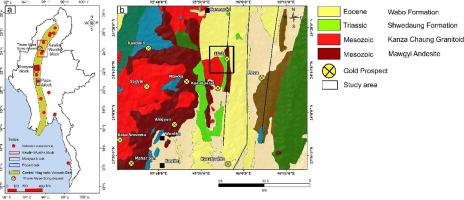Journal of Asian Earth Sciences ( IF 3 ) Pub Date : 2021-03-26 , DOI: 10.1016/j.jseaes.2021.104749 Htet Sandar Aung , Kotaro Yonezu , Akira Imai , Thomas Tindell , Koichiro Watanabe

|
Several gold deposits are found in the Central Magmatic-Volcanic Belt (CMVB) of Myanmar, which forms a nearly N–S-trending, 1500-km-long arc extending from the Andaman Sea to northern Myanmar. The CMVB consists of Cretaceous granitoids intruded into folded andesites and pillow basalts (Mawgyi Andesite) which rest on cherts, talc-schists, mudstones and phyllites. The EE3 gold deposit is part of gold mineralization in the Thone Myae Song area, located in the Kawlin–Wuntho block in the northern part of the CMVB. The orebodies occur as sulfide-bearing massive quartz veins hosted by Mawgyi Andesite. Based on the mineral assemblages and cross-cutting relationships, three mineralization stages are identified in the EE3 gold deposit: Stage-I quartz-carbonate-sulfide veins; Stage-II quartz-carbonate veins intersecting the Stage-I veins; and Stage-III quartz-carbonate-sulfide veins parallel to the Stage-I veins. The main hydrothermal alteration minerals are sericite, epidote, chlorite and calcite. Three main types of fluid inclusions were distinguished from the mineralized quartz veins hosted by Mawgyi Andesite: liquid-rich aqueous fluid inclusions (Type A), vapor-rich aqueous inclusions (Type B), and H₂O-CO₂-NaCl inclusions (Type C). The latter occurs only in the Stage-I veins. The ore-forming conditions are estimated from fluid inclusions in the Stage-I, Stage-II and Stage-III veins to be at 180 °C and 28 bars, 176 °C and 26 bars, and 158 °C and 21 bars, respectively. The formation pressures of the Stage-I, Stage-II and Stage-III mineralization correspond to a shallow depth of 300 m, 280 m, and 225 m, respectively. Based on the ore and alteration mineral assemblages, and estimated temperature and pressure conditions of the mineralization, the EE3 gold deposit was formed in an epithermal condition.
中文翻译:

缅甸北部实皆省Thone Myae Song地区的金矿化
在缅甸中部岩浆火山带(CMVB)中发现了几处金矿床,形成了一条近N-S趋势,1500公里长的弧,从安达曼海一直延伸到缅甸北部。CMVB由侵入白垩质安山岩和枕形玄武岩(Mawgyi安山岩)的白垩纪花岗岩组成,这些玄武岩靠在石,滑石片岩,泥岩和千枚石上。EE3金矿床是位于CMVB北部Kawlin–Wuntho区块的Thone Myae Song地区金矿化的一部分。矿体是由毛吉安山岩(Mawgyi Andesite)托管的带有硫化物的大块石英脉。根据矿物组成和横切关系,在EE3金矿床中确定了三个矿化阶段:I期石英-碳酸盐-硫化物矿脉; I期石英-碳酸盐-硫化物矿脉; I期石英-碳酸盐-硫化物矿脉。第二阶段的石英碳酸盐岩脉与第一阶段的脉相交;第三阶段的石英-碳酸盐-硫化物矿脉平行于第一阶段的矿脉。主要的热液蚀变矿物为绢云母,附子,绿泥石和方解石。莫威奇安山岩所拥有的矿化石英脉区分出三种主要类型的流体包裹体:富液体的含水流体包裹体(A型),富蒸气的含水包裹体(B型)和H 2 O-CO 2 -NaCl包裹体(C型) 。后者仅发生在I期静脉中。根据第一,第二和第三阶段矿脉中的流体包裹体估算成矿条件分别为180°C和28 bar,176°C和26 bar,158°C和21 bar 。第一,第二和第三阶段矿化的地层压力分别对应于300 m,280 m和225 m的浅层深度。根据矿石和蚀变矿物组合,



























 京公网安备 11010802027423号
京公网安备 11010802027423号